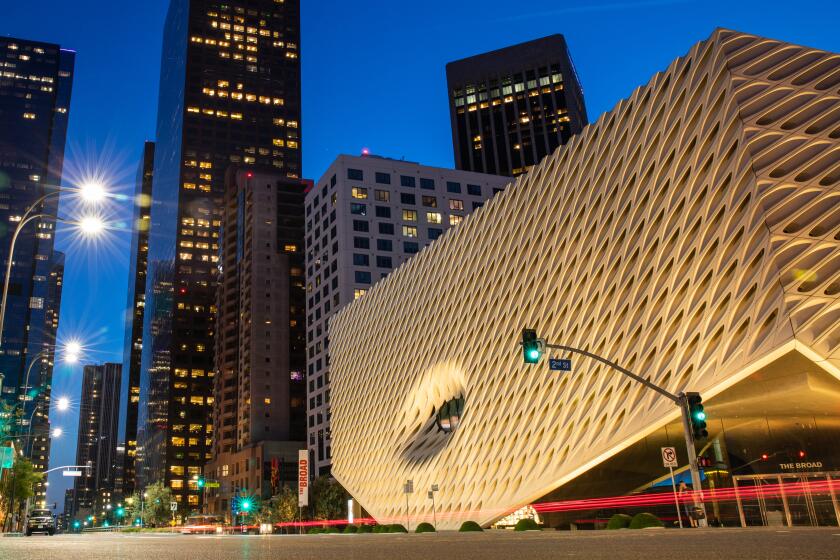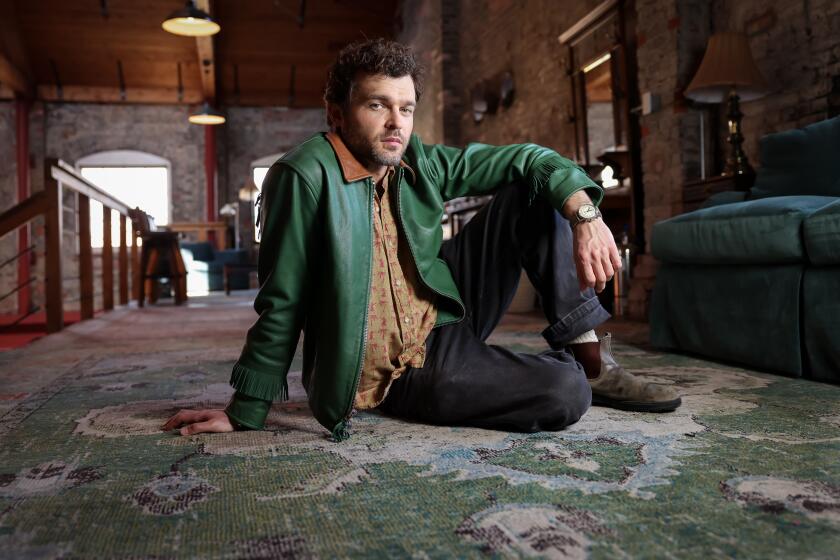ART REVIEW : Local Traditions Alive in FIAR Exhibit : The international show honors emerging artists, whose work tends toward the predictable. But the L.A. contingent also plumbs the visceral.
- Share via
The link between art and technology lives on in UCLA’s presentation of “Art Under 30: FIAR International Prize.” It’s the first edition of an invitational touring show launched by the Italian high-tech firm to celebrate its 50th anniversary.
Unfurling itself under the banner of internationalism, the exhibition nonetheless involves just four countries: Italy, England, France and the United States. Even given this somewhat limited Euro-American axis, Germany seems rather pointedly left out, considering its leading role in the revival of European modernism in recent years. Oh well, maybe they’ll rotate various nations in subsequent editions.
Artists were chosen by six regional curators plugged into the grass roots of their towns. After choosing 10 artists apiece, prizes were assigned by a jury. The top award went to London’s Callum Innes for his “Five Identified Forms.” The work looks a bit like a night sky streaked with glowing forms that could be anything from rockets to fireflies and is a nice thing. The prize of 8 million lira sounds like a lottery windfall but exchanges to just entry-level help at about $5,300. Four other cash awards were about half that.
Everybody approves of the idea of giving emerging artists a break. It’s clearly the right thing to do. If the prizes are not exactly princely, the exposure of the show in the half-dozen big cities involved surely gives the artists the beginnings of broad exposure. The downside of such exhibitions is the predictability of the product.
Artists this young tend to either be Wunderkinder who have already knocked the art world on its ear by the time they are twentysomething and don’t need invitational group shows, or earnestly talented people still struggling toward the flame of individuality. They listen to their teachers and follow trends. When shows like this come along they get chosen by curators trained in art history. Curators are often inclined to work that looks like something they already know. The resulting exhibitions are thus characteristically composed of work that gently nudges the boundaries of originality rather than bumptiously busting the borders.
The Los Angeles contingent here provides a ready case in point and--at the risk of lapsing into parochialism--also has the most interestingly original civic sensibility. Chosen by Marc Selwyn, the ensemble of the art has a very interesting shared aspect. We knew L.A. art has long striven for the sensual. Here it is exaggerated toward the visceral.
Back in the ‘60s Ed Ruscha started experimenting with odd art materials, drawing in gunpowder, chocolate, fruit juices and all manner of amusing substances. Here we find young Doug Hammett making “Finger Licks,” tall, slender bars rendered in white chocolate, lemon, vanilla and strawberry frosting. Rachel Lachowicz contributes “Decorum,” two circular plates centering on mammary forms and cast in burgundy lipstick. Michael Coughlan shows a sweet child’s nappy imprinted with bunnies and stained with a brown substance that looks offal but is in fact coffee spilled in Rorschach form. Laura Stein’s self-portrait is indefinably sexual.
Other L.A. people carry on other local traditions. Odette de Crecy is a Proustian name but the art is a very credible--if conservative--version of Light and Space art. Jamey Bair harks back to early Ed Moses in “Available.” Rory Devine gives us a charming conceptual version of an English Landscape painting in words such as blue, sky, hedges and fence.
Classical modernism shows up in a very keen shallow bas-relief by Robert Levine, whose black-and-white composition thinks about Diebenkorn thinking about Mondrian. The Abstract Expressionism that gave basic inspiration here in the ‘50s lives on in Danny Shain. The controversy ignited early on by the work of Wallace Berman and Ed Kienholz is revived in Manuel Ocampo’s “Tratado de empermeria.” It depicts an armed and mounted KKK figure gesturing belligerently toward a giant human skeleton. In the sky floats a swastika. Similar works by Ocampo caused a fuss at Germany’s most recent Documenta. They appeared as conscious provocation, which is not a good tactic.
A show like this cuts several ways. One is bound to notice that every currently practiced style cuts across national borders. One is bound to notice that, in spite of this, local characteristics refuse to go away.
New York is as brash and cheeky as ever in Jeff Robinson’s “Earl Scheib.” Aggressive invention shows up in a painting by James Esber, where abstract shapes become airplanes. The sentiment of the Soyer brothers lingers in John Francis Currin’s portrait of a black girl.
Artistically, London is hard to beat for the sheer personal eccentricity that turns up from Kate Bright to Jonathan Green. There’s a streak of nostalgia in Leslie Hakim-Dowek’s little reliquaries for flowers and Renny Tait’s longing for old Italian churches. Artists such as Harriet Mena Hill and Andrew Bick insist on intelligence as integral to the game.
Parisians have to be witty, casual and classical so Claude Queyrel’s “Plafond” looks like a palace ceiling that wants to be a beach ball and Pierre Huyghe’s “Le Negre” has the appearance of a headache pill ad turning into a philosophical tract on the stressful inner life of minorities.
It’s hard to imagine making art in Rome without the omnipresent Baroque finally getting to you. It does in Paolo Canevari’s rubber columns, Marco Colazzo’s emblematic abstraction and Frederico Fusi’s pretty glass.
Milan is chic and lively in reality but its art seems lost in Giorgio de Chirico’s metaphysical longings. Luca Pignatelli’s night view of New York’s customs house goes back to the beginnings of Futurism while Pierluigi Pusole’s “Fiat Levitmobile with Power Amp” updates it to a Pop Neo-Expressionism.
Everything passes. Nothing changes.
More to Read
The biggest entertainment stories
Get our big stories about Hollywood, film, television, music, arts, culture and more right in your inbox as soon as they publish.
You may occasionally receive promotional content from the Los Angeles Times.










